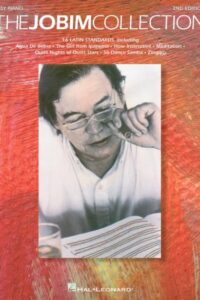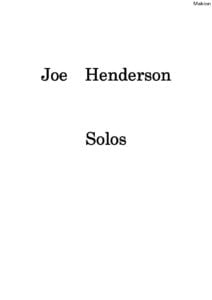Come join us now, and enjoy playing your beloved music and browse through great scores of every level and styles!
Can’t find the songbook you’re looking for? Please, email us at: sheetmusiclibrarypdf@gmail.com We’d like to help you!
Table of Contents
Jobim and Herdenson: Desafinado – Antonio Carlos Jobim & Joe Henderson (1994)

Best Sheet Music download from our Library.

Please, subscribe to our Library.
If you are already a subscriber, please, check our NEW SCORES’ page every month for new sheet music. THANK YOU!
From Carnegie Hall Salutes The Jazz Masters (1994).
Browse in the Library:
Or browse in the categories menus & download the Library Catalog PDF:
Two Giants on Different Paths: Jobim and Henderson
The musical and friendship cooperation between Antônio Carlos Jobim and Joe Henderson is a fascinating chapter in jazz history, representing a beautiful and respectful dialogue between two masters from seemingly different worlds. It was a meeting not of clash, but of confluence, resulting in one of the most beloved albums of both artists’ careers.
Their collaboration is primarily documented on the 1994 album “Double Rainbow: The Music of Antonio Carlos Jobim,” recorded shortly before Jobim’s death in December of that year.
- Antônio Carlos Jobim (1927-1994): By the 1990s, Jobim was a living legend, the undisputed father of bossa nova. He was a composer first, known for his sophisticated, melancholic harmonies and poetic melodies inspired by the Brazilian landscape. His instrument was the piano and, famously, his softly sung Portuguese. He was the architect of the sound.
- Joe Henderson (1937-2001): Henderson was a titan of the tenor saxophone, a modern jazz innovator. While he had deep roots in bebop and hard bop, he was known for his complex, angular phrasing, harmonic daring, and a tone that could be both rugged and tender. He was a master improviser, always searching and pushing boundaries.
On the surface, Henderson’s robust, exploratory style might seem antithetical to the gentle, precise nature of bossa nova. This is what makes their collaboration so special: they found the profound common ground between them.
The Nature of Their Musical Cooperation
The cooperation on “Double Rainbow” was built on a foundation of deep mutual respect. Henderson was not there to “jazz up” Jobim’s music; instead, he sought to internalize and reinterpret it through his own unique lens.
1. Henderson as a Devoted Interpreter:
Joe Henderson had a lifelong love for Brazilian music. He didn’t approach Jobim’s songbook as an outsider applying a jazz formula. He immersed himself in the nuances of the rhythm, the lyrics, and the emotional core of each song. His genius was in finding a way to honor the melody’s inherent beauty while still speaking with his own authentic voice.
2. The Blending of Sounds:
The album’s magic lies in its seamless fusion:
- Jobim’s Foundation: The rhythms are authentic and unwavering, provided by a stellar band including Oscar Castro-Neves on guitar and guitar legend Paulo Jobim (Tom’s son). This provided a lush, authentic Brazilian canvas.
- Henderson’s Brush: Over this canvas, Henderson painted with his saxophone. He played with a softer, more lyrical tone than on his own hard-bop records, but he lost none of his creative intensity. His improvisations are thoughtful, melodic expansions of Jobim’s themes, not disruptive departures from them.
3. A Conversation, Not a Monologue:
Tracks like “Zingaro” (Retrato em Branco e Preto) are perfect examples. Henderson’s saxophone doesn’t just play the melody; it sings it, imbuing it with a soulful, yearning quality that rivals any vocal rendition. On classics like “Desafinado” and “Insensatez” (How Insensitive), he respects the famous melodic lines before deconstructing them with his sophisticated harmonic knowledge, all while the rhythm section maintains the song’s essential heartbeat.
Jobim’s role was primarily as composer and guide. His presence on the album is felt more as a spiritual force than a performing one (he plays piano on only a few tracks). His approval of Henderson’s interpretations was the ultimate validation.
The Foundation of Friendship and Respect
While their time together was brief, the relationship was built on profound admiration.
- Henderson’s Reverence: Henderson spoke of Jobim with the utmost respect, often comparing his compositional genius to that of classical masters like Mozart or Ravel. He understood that Jobim’s music, while often serene on the surface, contained immense harmonic complexity and emotional depth—qualities that resonated deeply with a musician of Henderson’s caliber.
- Jobim’s Approval: For Jobim, who had seen his music interpreted (and sometimes misinterpreted) by countless artists over decades, Henderson’s approach was a revelation. It is said that Jobim was deeply moved by Henderson’s recordings. Henderson wasn’t just playing the notes; he was understanding the saudade (a deep, melancholic longing) at the heart of the music. This emotional connection transcended a mere professional session and became a true artistic kinship.
Legacy and Significance
The “Double Rainbow” album stands as a testament to the idea that great music transcends genre.
- It Reintroduced Jobim to the Jazz World: In the 1990s, bossa nova was sometimes seen as background music. Henderson’s serious, masterful treatment reaffirmed Jobim’s status as one of the 20th century’s great composers, worthy of the same deep study as Gershwin or Ellington.
- It Showcased Henderson’s Versatility: It highlighted a different, more lyrical side of Joe Henderson, endearing him to a wider audience and cementing his reputation as a complete musician, not just a jazz icon.
- A Benchmark for Cross-Cultural Collaboration: The album remains a gold standard for how to approach a revered songbook. It proves that the highest form of respect is not imitation, but true assimilation and personal expression, finding the shared human emotion that connects different musical languages.
In conclusion, the cooperation between Antônio Carlos Jobim and Joe Henderson was a late-career miracle for both. It was a brief but deep friendship founded on mutual awe, resulting in a musical dialogue where the gentle beauty of Rio’s beaches met the sophisticated edge of New York’s jazz clubs, creating something timeless and universally beautiful.
Joe Henderson – Double Rainbow (Full Album)
Joe Henderson – Double Rainbow – The Music Of Antonio Carlos Jobim Sello: Verve Records – 314 527 222-2 Formato: CD, Album País: US Publicado: 1995 Género: Jazz Estilo: Latin Jazz, Bossa Nova
Lista de Títulos Suite I 01.- Felicidade 4:45 02.- Dreamer (Vivo Sonhando) 5:24 03.- Boto 6:35 04.- Ligia 4:31 05.- Once I Loved (Amor Em Paz) 5:25 Suite II 06.- Triste 5:29 07.- Photograph 5:02 08.- Portrait In Black And White (A.K.A. Zingaro) 5:18 09.- No More Blues (Chega De Saudade) 6:41 10.- Happy Madness 3:13 11.- Passarim 5:40 12.- Modinha 4:32
Browse in the Library:
Or browse in the categories menus & download the Library Catalog PDF:
